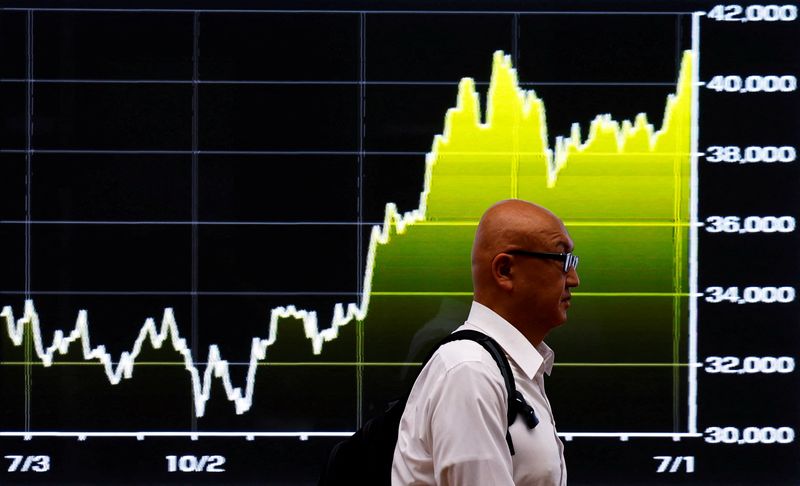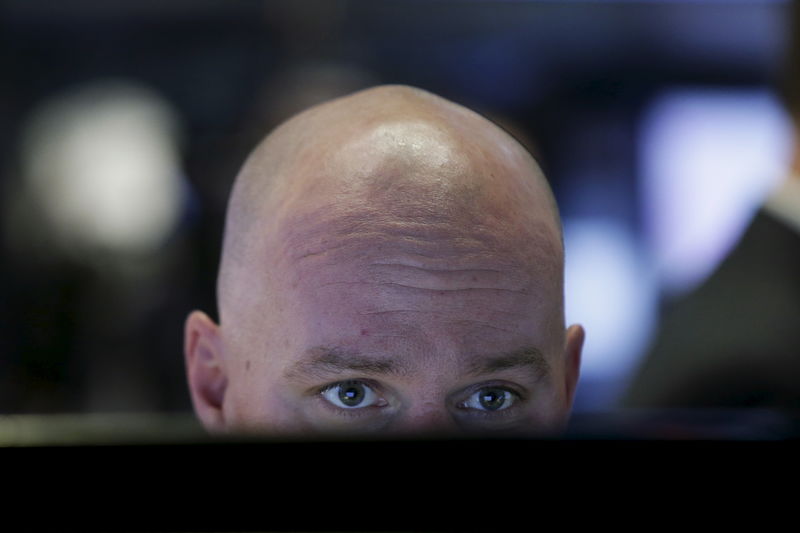By Kevin Buckland
TOKYO (Reuters) -Asian stocks traded cautiously on Friday after a mixed reading on the health of China’s economy, while Japanese markets were buoyed by a weaker yen.
The dollar hovered close to an 11-week high versus major peers on Friday after robust U.S. economic data allowed for a more patient path of Federal Reserve easing.
The U.S. currency was also supported by recent market contemplation of a potential election victory for Donald Trump, whose proposed tariffs and immigration policies are seen as inflationary. That helped gold push to a new record high.
Mainland Chinese blue chips sank 0.25% as of 0207 GMT, with property shares weighing, after data showed new home prices falling at the fastest pace since 2015.
Separate figures showed China’s economy expanded 0.9% in the third quarter, slightly below expectations for a 1.0% rise. The previous quarter’s growth was revised lower to 0.5%.
Beijing unveiled the biggest stimulus since the pandemic late last month, but investors have been frustrated by the lack of details offered by Chinese authorities in subsequent briefings.
“In a general sense, this is very backward looking data,” said Alvin Tan, head of Asia FX strategy at RBC Capital Markets.
“It basically confirms that the economy has been decelerating, … which is why there is this stimulus that was launched,” he said. “That’s the one that people are really focused on.”
Hong Kong’s traded 0.42% higher, lifted mostly by technology shares following solid earnings a day earlier from Taiwanese chipmaker and Nvidia (NASDAQ:) supplier TSMC. Taiwan’s equity benchmark climbed 2.57%.
Australia’s benchmark sagged 0.82% and South Korea’s slipped 0.38%. added 0.37%.
The , which measures the currency against six rivals including the euro and yen, eased slightly to 103.73, after climbing to 103.87 on Thursday for the first time since Aug. 2.
Overnight, data showed U.S. retail sales rose a stronger-than-expected 0.4% last month after an unrevised 0.1% gain in August. A separate report showed initial jobless claims dropped by 19,000 to a seasonally adjusted 241,000 last week.
Traders now have 74% odds of 50 basis points of interest rate cuts over the Fed’s remaining two meetings this year, down from 85.6% odds a day earlier, according to CME Group’s (NASDAQ:) FedWatch Tool.
“Robust retail sales data provided the Federal Reserve with greater flexibility in its rate path,” said James Kniveton, senior corporate FX dealer at Convera.com.
“Unlike the euro zone, the Fed does not need to adjust policy to support the economy.”
The European Central Bank cut rates by a quarter point on Thursday, as expected, and four sources close to the matter told Reuters that policymakers were likely to cut again in December.
The euro edged up to $1.0834 after dipping to $1.0811 in the previous session, the lowest since Aug. 2.
The dollar eased 0.12% to 150.04 yen, after jumping to 150.32 yen overnight, piercing the psychological 150 barrier for the first time since Aug. 1.
Democratic presidential candidate Kamala Harris’ edge over Republican Trump has narrowed from a late September lead of seven points to just three, Reuters/Ipsos polling shows. And the rivals are statistically tied in the seven crucial battleground states that will decide the race.
“The USD (is) well-positioned to extend its rally as it continues to price in a Donald Trump election victory,” said Tony Sycamore, an analyst at IG.
Gold rose to a new record high of $2,707.90.

inched higher on Friday, supported by a surprise drop in U.S. oil inventories and simmering Middle East tensions, but prices were headed for their biggest weekly loss in more than a month on worries of lower demand.
futures rose 0.31%, to $74.68 a barrel, while U.S. West Texas Intermediate crude was up 0.38% at $70.94 a barrel.


